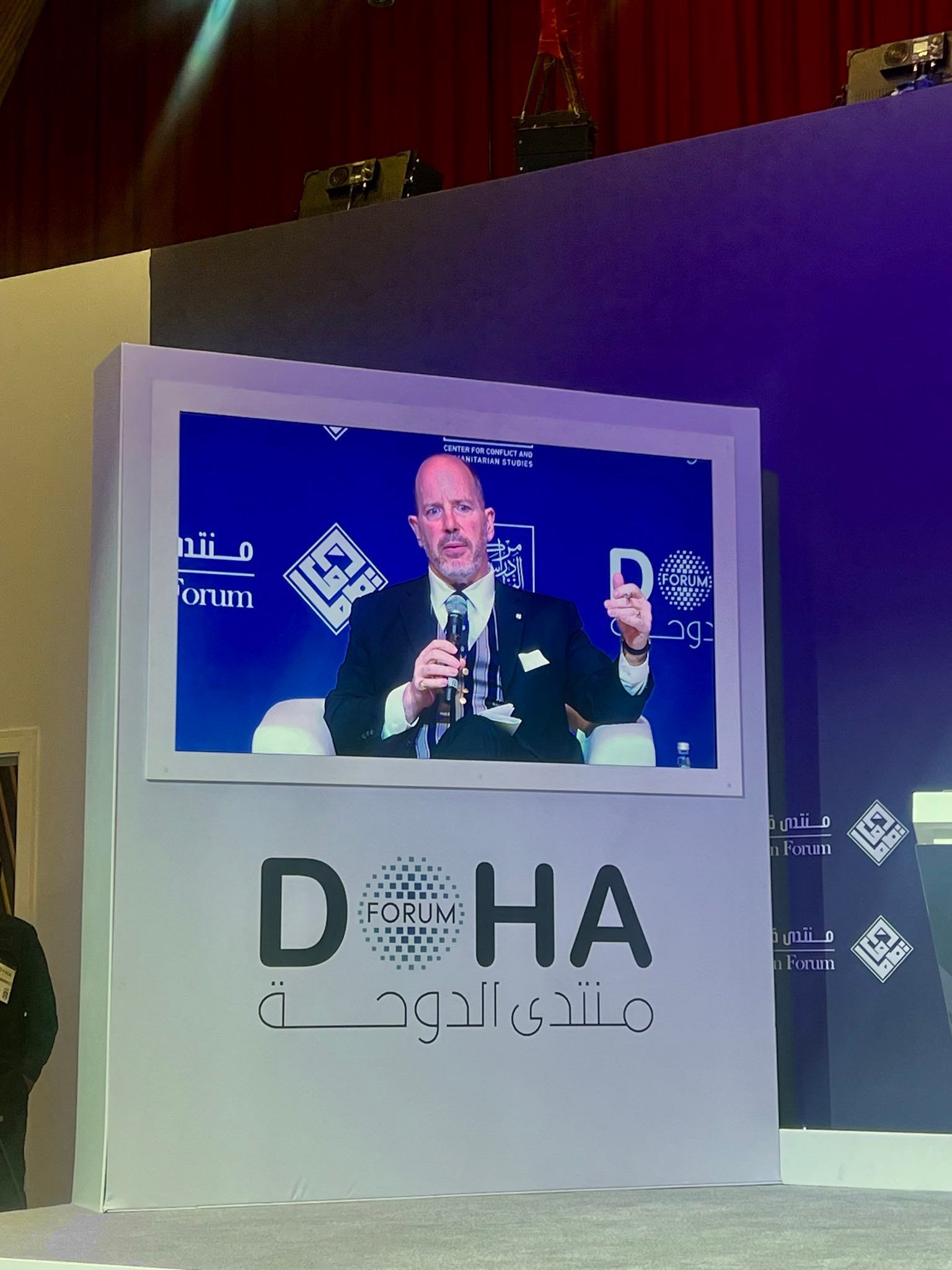Transatlantic Turbulence in Nuclear Weapons and Deterrence
Below is the text upon which Dr. Ford drew in delivering his remarks at a conference on "Transatlantic Turbulence: What Next for European Defence?" held at the University of Birmingham on June 13, 2025.
Good afternoon and thank you for inviting me.
You certainly don’t need me to describe the security threats facing the Atlantic Alliance from Russian aggression today. As someone who has spent my career in the U.S. national security and foreign policy community, however, let me focus more on the “transatlantic” piece of the problem – which is to say, the remarkable period in which we find ourselves in terms of U.S. policy. So with the usual caveat that I can only offer my personal views, which will not necessarily represent those of anyone else, let me offer a few thoughts.
The “American Question”
There is little question that, whatever it actually is today, the United States commitment to supporting the countries of Europe and the NATO alliance is no longer quite what it once was. But the reasons for this go far beyond just the problem of Europe’s still lackluster defense and security policies. (After all, U.S. presidents have been calling upon Europe to spend more on its own defense since at least 2002, and even Barack Obama – no Republican security hawk he – felt it necessary to call out the Europeans for being “complacent” about their own security.)
The additional wrinkle today stems from the way that “Europe” appears to resonate in current U.S. domestic politics to some of the people in under the Second Trump Administration. When I say “Europe” in this context, however, I mean it not in a strictly geographic sense, but rather in a broader and more figurative one that lumps together all the relatively politically progressive developed Western democracies, not excluding Canada.
From the standpoint of many in the modern American populist Right, this socio-cultural “Europe” appears to be understood primarily through the prism of U.S. domestic politics. Indeed, the countries of “Europe” are seen as de facto extensions of America’s domestic politics. Specifically, those countries are seen as being essentially clones, or at least siblings or allies, of the domestic political opposition to President Trump in the Democratic Party.
With the exception of European countries where right-wing parties have managed to win power, in other words, the democracies of Western Europe are thus assumed to be inherently hostile to the MAGA movement, and hence also axiomatically hostile to the United States. Thus, for example, could President Trump declare even back in 2018, that “the European Union is a foe.”
These attitudes hardened after Trump’s election loss in 2020, and today they seem to represent a powerful current within the Second Trump Administration’s foreign policy thinking.
This shift has been most obvious in things such as Vice President Vance’s famous speech to the Munich Security Conference, where he decried the role of European governments and EU “commissars” in suppressing disfavored speech, comparing them explicitly to what he said were the policies of the Biden Administration in the United States. According to Vance, in fact, the biggest threat in Europe is not Russia, China, or “any external actor,” but rather “the threat from within” he said was posed by those seeking to enforce progressive political norms upon the European population. (It should perhaps not have been surprising, then, that on that same trip, Vance chose not to meet with German Chancellor Olaf Shultz but did meet with the leader of Germany’s far-right Alternative für Deutschland (AfD) party. In fact, then-Trump senior official Elon Musk had actually publicly urged Germans to vote for the AfD.)
These dynamics are also visible elsewhere. Today, for instance, the U.S. Department of State under Marco Rubio – written by someone named Samuel Samson, who is described as a “Senior Advisor for the Bureau of Democracy, Human Rights, and Labor” – emphasizes the importance of building and maintaining relationships with “civilizational allies” in Europe. Who these allies are and what civilization is referenced are not clearly specified in Samson’s paper, but that same document defends the AfD and far-right French politician Marine LePen as being victims of progressive leftist suppression. It also also defends “Christian nations like Hungary” against charges that their politics have turned authoritarian and self-avowedly “illiberal” under rulers such as Viktor Orbán.
These perspectives may also help explain the sympathies that some in the MAGA ecosystem seem to show toward Vladimir Putin and his vastly more illiberal and authoritarian regime in Russia. Putin, after all, has himself rather leaned into political narratives that outdo even MAGA partisans in their hostility to modern Western progressivism. To hear Putin tell it, for instance, the values of the modern West represent nothing short of “Satanism.” He says he believes the West to be a hotbed of “paedophilia,” and his regime persecutes the Russian LGBTQ community under sweeping laws that criminalize “extremism.”
Accordingly, if a figurative “Europe” is America’s foe due to its commitment to progressive political values, it’s not too hard to imagine right-wing Americans assuming that Russia must therefore be something not unlike our friend. The media has widely reported President Trump’s ambivalence on this score, but such thinking may also help explain why then-Trump senior advisor Elon Musk could call one U.S. Senator a “traitor” merely for having visited Ukraine.
Since the U.S. Code specifies that the crime of treason consists of levying war against the United States or adhering to its enemies, for an American to be a “traitor” for supporting Ukraine, it must therefore be the case that Musk thinks Ukraine our enemy – making us, one might infer, Russia’s ally. Musk being Musk and an inveterate social media troller, it may be that this particular comment was not – how to put it? – carefully thought through, but it is at least suggestive of an attitude quite different from prior U.S. views of Moscow.
At the very least, there seems to be a remarkable lack of any feeling of threat from Russia. Just yesterday, in fact, the U.S. Deputy Secretary of State described NATO as being “a solution in search of a problem.”
It is also true, of course, that – apparently surprised by the Russian dictator’s entirely unsurprising refusal to stop attacking Ukrainian civilians – Trump has more recently called Putin “CRAZY” (in all-caps). This may be somewhat more reassuring to Europeans, but it also still underlines the more basic point: our allies may feel that they haven’t the foggiest idea what to expect from American policy from one day to the next. And that’s got to be somewhat worrisome from the perspective of a U.S. ally whose security relies upon the United States absolutely being there in a pinch, when things are really tough.
For present purposes, I will myself take no position on the merits or demerits of current U.S. policy but such apparent sentiments unquestionably present novel challenges to America’s traditional international security partnerships, including –especially – the transatlantic community and the NATO alliance.
Is China Different?
For those of us who focus, in particular, upon strategic competition with China, one key question is whether – or to what degree – this new strain in U.S. foreign policy thinking will have spillover effects upon deterrence in the Indo-Pacific. I could see this going one or the other of two very different ways.
On the one hand, it is easy to imagine that U.S. allies in Asia would find it deeply disturbing to see the Americans backtracking on their longstanding commitment to NATO for what purport to be principled reasons. This would go notably beyond simply acknowledging the obvious strains being placed upon both our nuclear and conventional force posture from having to deter territorial aggression by two near-peer nuclear great powers, in two theaters, at the same time. If this really is, instead, about issues of principle, if we cannot be trusted to support our allies in one theater, how could they trust us to stick with them in another?
On the other hand, however, it may be that the Indo-Pacific is “different.” To be sure, U.S. allies in the Indo-Pacific are no paragons of high defense spending and national security seriousness either. Nevertheless, the governments of Japan, South Korea, the Philippines, and Taiwan do not map onto American domestical political narratives and culture war disputes as clearly as the democracies of Western Europe might seem to do. (Australia may be a more complicated case, especially under the current Labour government of Anthony Albanese, which recently surged back into power on a wave of political anger at Donald Trump’s tariff policies, much like Mark Carney’s Liberals did in Canada.) Perhaps the political dissimilarity of most of our Asian allies makes American commitments in the Indo-Pacific less politically problematic in MAGA eyes.
From the MAGA perspective, it may also be that China itself is different. Very different. The People’s Republic of China, after all, is not, like Russia, an authoritarian regime claiming to ground its politics in traditional Christian religiosity, supported by a cadre of militant Christian clerics, and taking strident “culture war” positions against Western progressive political values and woke identity politics. China is, on the contrary, a much more culturally and racially “alien” dictatorship – and one, quite significantly, that officially adheres to the “godless” theories of atheistic Communism.
For both of these reasons, it may therefore not follow inexorably from the weakening U.S. commitments to NATO that our allies should also count us out in the Indo-Pacific. Perhaps Asia really is “different.”
Even if this were the case, of course, our Asian allies may not see things that way, and may still find it disturbing to think we might be willing to abandon even the region of the world out of which our deepest American traditions actually grew. Nor would there be any guarantee that China would understand this distinction either, perhaps concluding from the Second Trump Administration’s distaste for our European allies – whom our Secretary of Defense has described in all-caps as “PATHETIC” – that we wouldn’t really be willing to defend our allies in the Indo-Pacific either. (Such misunderstandings in Beijing, of course, could lead to a failure of deterrence.)
I also recognize that even if our alliances in the Indo-Pacific remain today just as strong as ever, this would be small consolation for Europe.
Nuclear Weapons Pressures
So what of Europe, then? From the perspective of nuclear weapons policy and deterrence, what might all his mean for the transatlantic relationship?
Well, one obvious challenge stems from the ways in which all this is putting pressure on the nonproliferation regime. In particular, they may be giving new incentives to the countries of Europe to consider building up their own nuclear weapons capabilities, not merely in terms of an enlargement and diversification of the existing British and French arsenals, but potentially even through proliferation to additional states.
After all, even before the arrival of the Second Trump Administration signaled the beginning of a period of reduced U.S. commitment to NATO, the mainstream American national security policy community, at least, was already coming around to the idea that the United States once again needs to be building more nuclear weapons systems. On this, the traditional “Doves” in the Democrat Party seem to have ended up reluctantly agreeing with traditional Republican “Hawks.”
It isn’t too surprising, of course, for hawks like me to be calling for a stronger U.S. nuclear force posture in response to China’s shocking nuclear buildup and the advantages we have allowed both Russia and China to develop in theater-class nuclear systems. Nor is it surprising for other conservative American think tank scholars to be advocating uploading more warheads onto U.S. strategic delivery systems.
But things have moved far beyond that. In 2023, the bipartisan Strategic Posture Review Commission (SPRC) reached the unanimous conclusion that the existing U.S. nuclear delivery system modernization program, while necessary, was no longer sufficient to meet our nuclear force posture needs. More remarkably still, by the time it left office, even the Biden Administration had begun hinting rather openly that the United States would likely need more nuclear weapons in order to respond to today’s threats and deter tomorrow’s – a message that Biden officials conveyed in both June and August of 2024.
Agreement had certainly not yet crystallized on exactly what (and how many) new things might be needed, but it is clear that by late 2024, a consensus had indeed formed among mainstream national security experts on both sides of the political aisle in Washington that stable deterrence today requires more Western nuclear weapons and delivery systems.
To the degree that this is the case – and if the burden of deterring Russia, at least, now needs to fall more and more on European shoulders in light of the policies of the Second Trump Administration – this obviously begs all sorts of questions not just about America’s future nuclear posture, but also about that of Europe. Such questions are a long way from being answered, but already we have seen the President of Poland call for the deployment of U.S. nuclear weapons to Polish soil, the President of France speculate about the possibility of extending a French “nuclear umbrella” to other countries in Europe, and British officials reportedly consider once again acquiring dual-capable aircraft capable of delivering nuclear weapons.
All this should make our discussions on this panel very interesting.
Where Will (or Can) All This Go?
Speaking as someone who has worked on strategic competition and nuclear weapons issues for most of my professional career in Washington, moreover, I find it striking how little the MAGA movement seems so far to have focused upon nuclear weapons and deterrence policies at all. (They have clearly had other priorities, such as immigration and what they describe as “deconstruct[ing] the administrative state” and its “woke and weaponized bureaucracy.”) Where their nuclear weapons thinking will end up going thus seems to be still somewhat up in the air.
On the one hand, President Trump seems to be fiercely devoted to the idea of a “Peace Through Strength” approach to international relations. To the limited degree that his administration can be understood based upon precedents and principled consistency, moreover, it’s worth remembering that in Trump’s first term, he moved quickly to deploy a new, lower-yield warhead (the W76-2) and began work on a new, submarine-launched nuclear-armed cruise missile (the SLCM-N) in order to provide new U.S. nuclear capabilities to at least partially counteract and deter threats from existing theater-level systems in both Russia and China.
On the other hand, President Trump also seems to hate and fear nuclear weaponry, feelings he seems to have held since the 1980s. As a self-proclaimed master of the “Art of the Deal,” moreover, Trump has spoken about his desire for what he (somewhat confusingly) calls “denuclearization” talks with both Russia and China, which he hopes could lead to significant reductions in all three countries’ arsenals.
Trump’s recent advocacy for the so-called “Golden Dome” missile defense system only deepens the mystery of where MAGA nuclear thinking is headed. That idea, of course, has riled our strategic adversaries in China and Russia, who claim – as of course they would, especially if it ever works – that Golden Dome will be “deeply destabilizing.”
Yet in Trump’s new plan it is impossible not also to see resonances of President Ronald Reagan’s famous “Strategic Defense Initiative” (SDI) effort of the early 1980s, which horrified and infuriated the Soviets but also helped lead to what was ultimately a tremendous Reagan breakthrough in arms discussions with Moscow – and even to some quite unprecedented (albeit unfruitful) speculation between Reagan and Mikhail Gorbachev about possibly abolishing nuclear weapons altogether. Nor should one forget that our pursuit of the SLCM-N system in the First Trump Administration was expressly predicated in part upon the hope, as the 2018 Nuclear Posture Review put it, that the new SLCM-N system
“may provide the necessary incentive for Russia to negotiate seriously a reduction of its non-strategic nuclear weapons, just as prior Western deployment of intermediate-range nuclear forces in Europe [in response to Soviet deployments of SS-20 systems] led to the 1987 INF Treaty.“
So what is one to make of all this?
I certainly cannot claim that the volatility and inconstancy of Second Trump Administration policies do not still represent a daunting “wild card” in all debates about the possible nuclear future. Nevertheless, it may yet be that as we stand on the verge of seeing the last existing strategic arms treaty evaporate upon New START’s expiration in February 2026, some essential conceptual ingredients may already exist for a weird sort of constructive convergence between the more traditional elements of the U.S. nuclear weapons and deterrence expert policy community – including both deterrence hawks and arms control doves – and elements of the MAGA ecosystem concerned with maintaining deterrence and responsibly managing nuclear risks in a “Peace Through Strength” era.
If it were to concern only nuclear weapons posture and policy, of course, such an intellectual convergence would not necessarily answer all the mail, as it were, with respect to the challenges of deterring conventionally-armed aggression by Russia or China. To handle that, even were a new era of negotiated nuclear restraint to reduce the salience of nuclear weaponry in such disputes, we and our allies in both theaters would need to find new and better ways of building up our collective strength and divvying up the burdens of the deterrence that remains in all our interests.
My point, however, is that when it comes to possible nuclear futures, we really are at an extraordinary point in which a broader range of potential scenarios – some good, and some bad – are becoming more conceivable than ever before. And that makes this a fantastic point at which to have the kind of discussions we are having here today.
Thanks again for inviting me to the University of Birmingham.
—Christopher Ford









